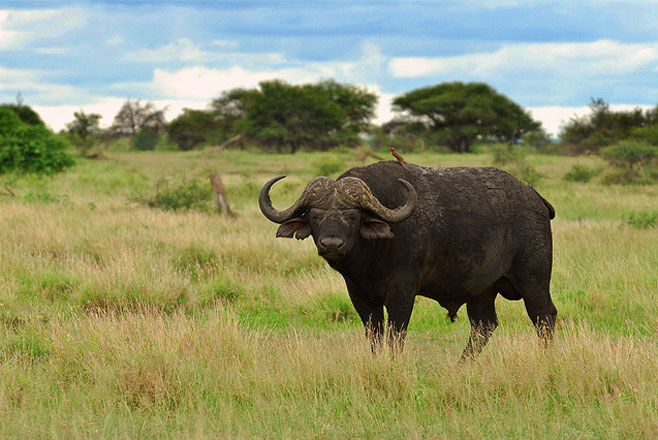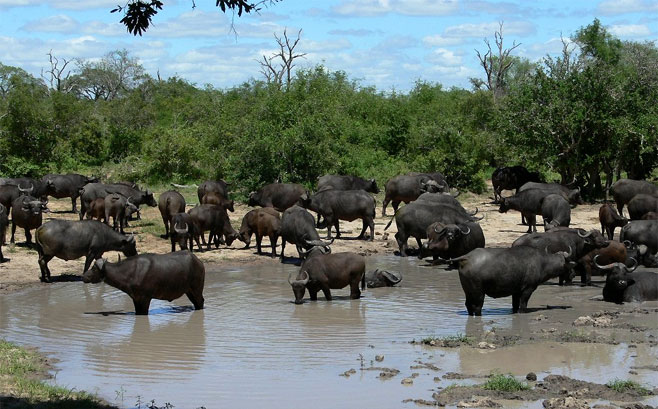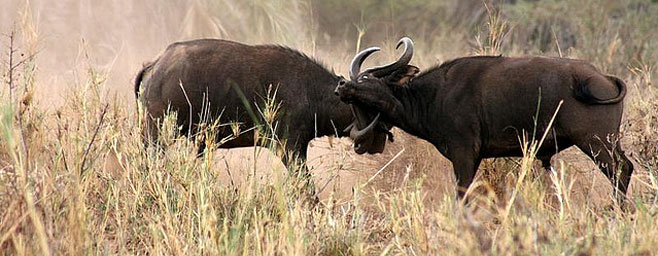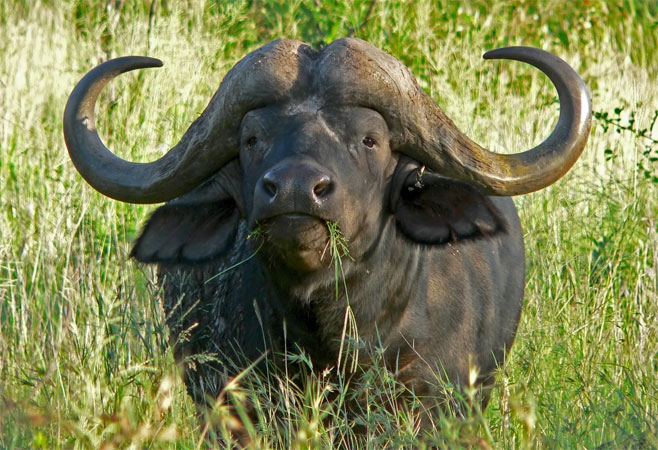|
Syncerus caffer (African buffalo)
buffalo [English]; buffel, Arika-buffel
[Afrikaans]; Büffel [German]; bume d' Afrique [French]; nyati, mbogo
[Swahili]; inyathi [isiNdebele] [isiXhosa] [isiZulu]; nare [Sepedi]
[Sesotho]; nare [Setswana]; nyati [Shona]; inyatsi [siSwati]; nyarhi
[Xitsonga]; nari [Tshivenda]; nali [Lozi] unyati [Yei]; |Goab [Nama]
[Damara]
Life
>
Eukaryotes >
Opisthokonta >
Metazoa (animals) > Bilateria > Deuterostomia >
Chordata > Craniata > Vertebrata (vertebrates) >
Gnathostomata (jawed vertebrates) > Teleostomi (teleost
fish) > Osteichthyes (bony fish) > Class:
Sarcopterygii (lobe-finned fish) > Stegocephalia
(terrestrial vertebrates) > Reptiliomorpha > Amniota >
Synapsida (mammal-like reptiles) > Therapsida > Theriodontia
> Cynodontia > Mammalia (mammals)
> Placentalia (placental mammals) >
Laurasiatheria > Ferungulata > Cetartiodactyla (even-toed ungulates and cetaceans)
> Ruminantia (ruminants) > Family:
Bovidae (antelopes and buffalo) >
Subfamily: Bovinae
 |
|
African buffalo, Kruger National Park, South
Africa. [photo
Callie de Wet ©] |
 |
|
African buffalo herd, Kruger National Park. [photo
Arno Meintjes
©] |
 |
|
African buffalos fighting, Kitani,
Kenya. [photo
Crazy
Kanga ©] |
Identification
Buffalo are massive, heavily built ungulates
that resemble cattle. Adult bulls are dark-brown to black in colour
and cows are not as dark. Calves are reddish brown. Both sexes have
heavy, large horns that are in the shape of a shallow “w”. The
average horn length from the central boss following the curve to the
tip is 1m. The central horn “boss” is particularly well-developed in
the bulls forming a “helmet-like” structure over the top of the
head.
One of the “Big Five” in Africa, buffalo are a
highly popular tourist attraction in national parks, this makes them
highly prized as an important source of income.
Distribution and habitat
Eastern and northern areas of the
southern African subregion, with an isolated population remaining in
the Addo Elephant Park of the Eastern Cape Province. Buffalo prefer open woodland savanna but
tolerate a wide range of habitats with abundant grass, drinking
water and cover.
Size
Height at shoulder 1.4 m; weight 700 kg
(male) and 550 kg (female)
Dental Formula
I C C P P M M =
32 =
32
General behaviour
Buffalo are social and can form herds
consisting of several thousand animals. These very large herds may
break into smaller groups that will rejoin the main herd later. A
dominance hierarchy exists amongst adult bulls in the mixed herd.
Cows also have a pecking order within the heard.
Food
Grazers, but will occasionally browse.
 |
|
African buffalo, Satara area of the Kruger
National Park, South Africa. [photo
Francois Dreyer
©] |
Reproduction
Buffalo are seasonal breeders with calves being
born in the wet and warm summer months, after a gestation period of 340 days. Calves are born in the herd
and are able to keep up with the herd a few hours after birth. The
herd is collectively protective of young and calves will usually be
ushered to the centre of the herd when danger threatens, with the
adults forming a “guard” on the outer perimeter of the herd.
Life span
15 years and up to 30 years in captivity
Conservation
While still relatively numerous the
number of African buffalo has been greatly reduced by hunting and habitat
loss. The populations in several southern African localities have
never recovered from the devastating rinderpest outbreak of the
1890s. Buffalo are not regarded as endangered but only exist in
numbers within the protection of parks and reserves. Their
conservation status is lower risk – conservation dependent. Probably
the greatest threat comes from the bushmeat trade.
Text by Denise Hamerton |
